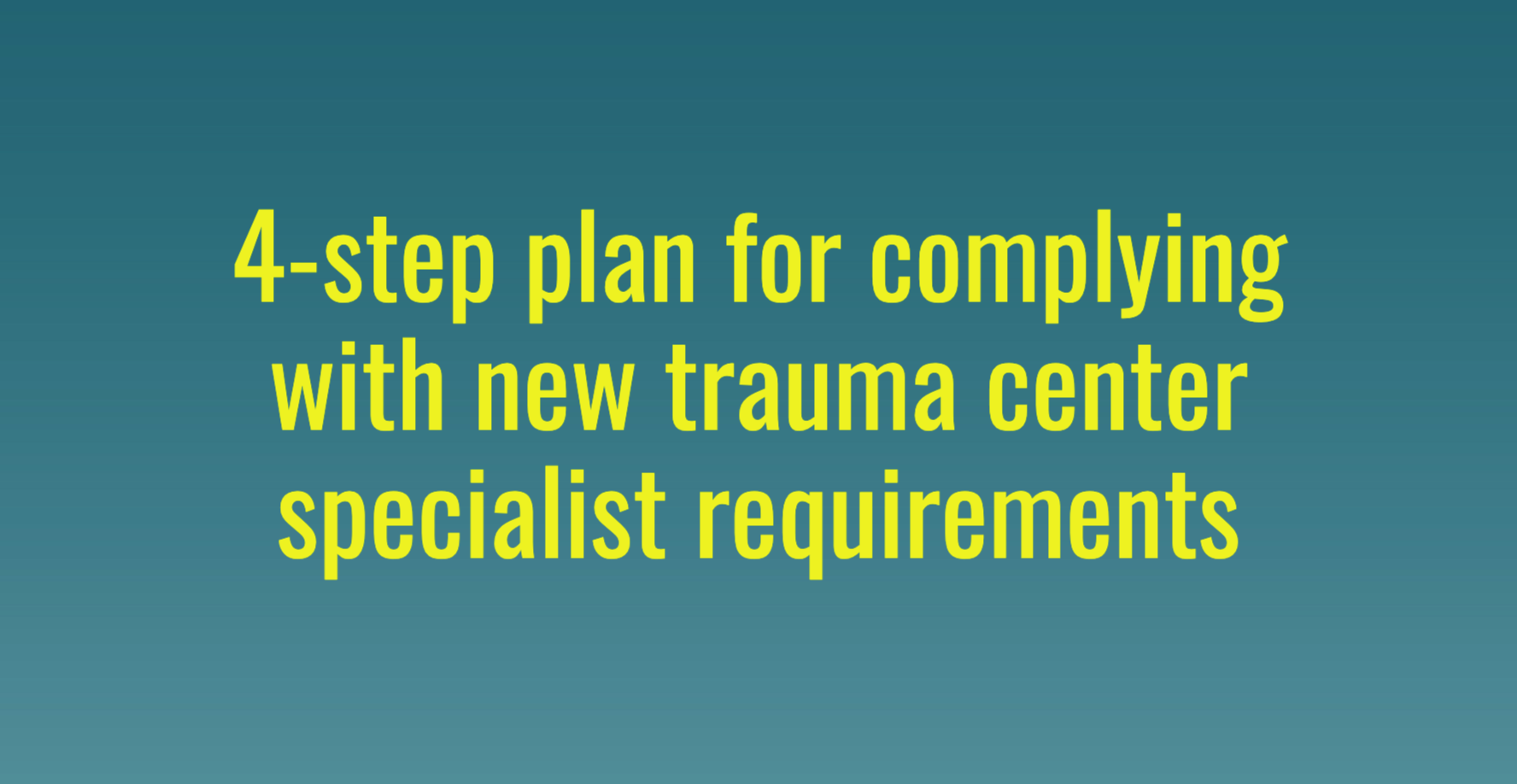The 2022 trauma center standards from the American College of Surgeons (ACS) include several new requirements for surgical and medical specialists. These expertise requirements will improve care for injured patients, but they also create potential compliance challenges for trauma program leaders.
As it is, most trauma programs struggle to secure adequate funding for existing services. Unfortunately, the new specialist availability expectations in Resources for Optimal Care of the Injured Patient: 2022 Standards will require many hospitals to make additional financial commitments.
How can trauma program leaders get the resources they need from C-suite executives? The four-step plan outlined below will help you leverage creative thinking and solid data to make sure your center has all the specialists it needs to comply with the new ACS standards.
1. Understand the flexibility built into the new standards
At first glance, the physician coverage requirements in the 2022 Standards are daunting. Depending on your center’s designation level, you will need to secure several new surgical specialists, medical specialists and expert capabilities. These specialists are not only expensive, many are in short supply.

But it is important to take a careful look at the standards. Most of the new coverage requirements actually provide significant leeway and a range of alternatives.
Some expertise requirements can be fulfilled by several different specialties. For example, adult and pediatric Level I centers must have expertise for managing craniofacial injuries (Standard 4.24). However, this expertise does not necessarily need to be provided by an oral maxillofacial (OMF) surgeon. Coverage by either an otolaryngologist or a plastic surgeon will fulfill the requirement.
Several models of care are acceptable. The craniofacial standard also states that centers can secure coverage using any one of several models. The model could be “a single specialty covering all injuries, a rotating schedule, or involvement of specific expertise depending on the nature of the injuries.” Presumably, a center could contract with an ENT to cover most craniofacial injuries and engage an OMF surgeon to cover the most complex cases. This could reduce overall expenses by matching specialty costs to case acuity.
Some specialist requirements can be fulfilled with a transfer protocol. The 2022 Standards include a new expectation for the availability of replantation services (Standard 4.25) that applies to adult and pediatric Level I and II centers. Fortunately, there are options. Centers “must have replantation capability continuously available or must have in place a triage and transfer process with a replant center” (emphasis added). Similar alternatives are available in the requirement for specialized orthopaedic trauma care (Standard 4.12).
In addition, consider that some specialist coverage challenges can be addressed at the regional level. For example, if maxillofacial surgery expertise is in short supply in your area, your trauma program could work with other centers to share one OMF across multiple hospitals. This possibility is unstated in the new ACS standards, but it is worth exploring.
2. Use registry data to accurately define call burden
Anyone who goes “shopping” for surgical specialists today will likely experience sticker shock. Depending on the local market, many specialists will request exorbitant coverage fees. But be aware that this is the “list price” — there is often ample room to negotiate these fees down based on actual coverage need.
First, realize that the ACS standards specify which specialties a trauma center needs; for the most part, however, they do not specify which clinical situations need to be covered. Centers are usually free to define which emergent conditions require a specialist response.
For example, say you are the TPM or TMD of a Level I center and you need to secure soft tissue coverage (Standard 4.23). You talk to a local plastic surgeon who wants $365,000 to cover this service. After you pick your jaw up off the floor, do the following:
- Define the emergent conditions that the plastics service will need to respond to. For instance, program leaders might specify these as any facial injuries, hand injuries or soft tissue injuries.
- Run a registry report to determine how many of these events occur annually. Depending on your patient population, you might need plastic surgery coverage only 10 to 15 times per year.
- Provide this data to hospital leadership. The contracting department can use it to negotiate a coverage agreement that takes expected volumes into account.
This simple approach could secure plastic surgery coverage for a fraction of the initial request. Applying the same process to all your specialty contracts will help enable full compliance.
3. Clearly communicate the need to hospital executives
Under the new standards, trauma program leaders will have to make several new “asks.” In my experience, many TPMs and TMDs are unsure how to approach hospital executives with this kind of request.
One common problem is providing too much detail. Yes, the requirements are complex, but executives do not need to know the back story. Another common problem is focusing on the emotions inherent in the situation. You may be on high alert about the new standards, but executives want to make decisions based on facts.
The key is understanding how to tell the story clearly to C-suite leaders. When presenting a financial request to hospital executives, I recommend using an organized communication framework such as SBAR (Situation, Background, Assessment, Recommendation) or PDG (Problem, Definition, Goal).
Here is an abbreviated example of using the SBAR framework to present a specialty support request:
| Situation | The new ACS trauma center standards require us to add a psychiatrist to our program (Standard 4.26). |
| Background | Complying with this standard is critical to retaining our Level III status. We have about 24 months to comply before our next survey. |
| Assessment | This is a new budget commitment, but there is potential to leverage this new specialist to support other hospital service lines. |
| Recommendation | Begin recruiting a psychiatrist to cover trauma and cross-cover other inpatient services such as cancer and/or geriatrics. |
This communication strategy can be applied to any financial requests tied to the new standards, which may include more trauma registrar FTEs (Standard 4.31), more PI coordinator FTEs (Standard 4.35), additional OR facilities (Standards 3.2 and 3.3) and other needs.
One more note: Above, I recommended de-emphasizing emotion. However, do not hesitate to use “regulatory requirements” and “our trauma center designation” to get executive attention. In most hospitals, these points establish a burning platform that will spur executive action.
4. Demonstrate the value of compliance
An organized pitch is only the start. Trauma program leaders also need to speak the language of the C-suite by demonstrating value. In other words, show how the specialty coverage you are requesting will improve quality, generate revenue and drive better patient outcomes.
The most useful tool here is a financial pro forma that projects both specialist call pay and specialist-generated revenue. Discussions with hospital leaders will often provide a great segue:
CEO: “How are we going to pay for this?”
TPM: “Let’s do a pro forma. I’ll help by pulling registry data on patient volumes.”
A detailed pro forma based on good data can often make a strong business case for new specialty coverage. For example, a cardiothoracic surgeon might request call pay of $750,000, but downstream revenue could be $3 million.
Trauma program leaders can also help develop appropriate performance metrics for specialist contracts. For instance, a CT surgeon contract could include performance improvement targets for administering VTE prophylaxis and reducing VAP for thoracic trauma patients. The contract could also include an annual bonus tied to these metrics. These pay-for-performance incentives will help ensure the hospital derives benefit from any new specialty support contracts.
Range of strategies
The new specialist availability standards are only one resource demand. In the coming months, many trauma program leaders will need to request funding for additional program staff, additional education, additional facility resources and other compliance needs.
Fortunately, there are effective strategies for addressing all these funding challenges. For most centers, the biggest opportunity is simply to increase trauma patient revenue through better billing. (To find out more, read 5 coding and billing mistakes that reduce trauma center revenue and Trauma Billing: A concise guide to capturing lost charges for critical care.)
Other strategies include freeing up resources by reducing redundancy in registry and PI processes, securing more state funding by optimizing performance on state program metrics, and securing hospital grant funding through creative trauma center naming opportunities.
Taken together, these strategies can ensure that your trauma program has the resources it needs to comply with all the new ACS standards.
Angie Chisolm, MBA, BSN, RN, CFRN, TCRN is a nationally recognized expert in trauma program operational efficiency, coding and billing, site survey readiness and performance improvement. Angie is also president and managing partner of Optimal Healthcare Advisors.

